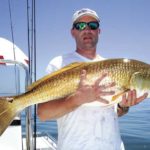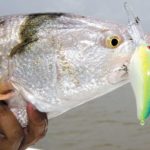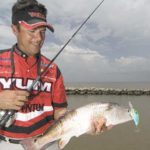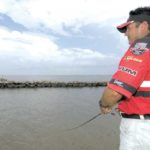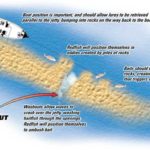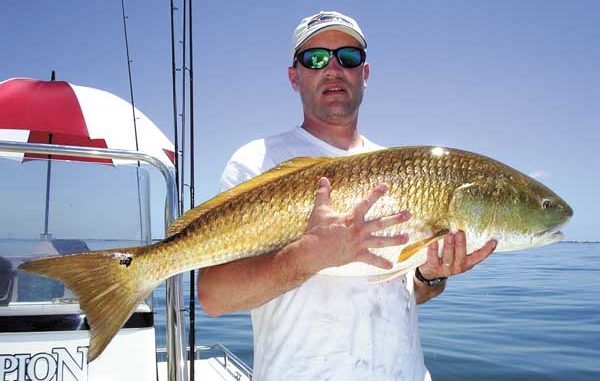
Giant redfish swarm at the jetties along Louisiana’s coast this month, and there’s no better way to catch them than with big crankbaits.
Art Cosby Jr. is one of my favorite people to fish with. Really, he is. But on this fall day, the man wanted to go catch bulls in Southwest Pass. As much as I love to fish reds, my idea of fun isn’t tying in with bulls in deep water. Shallow water, where fish can’t dive deep and sit there while I crank on them, is what stokes me. I want to hear the drag scream as reds streak away from me.
So I’d generally rather stay home and bounce a hammer off my thumb than target bull reds.
However, I knew Cosby hails from Starkville, Miss., and doesn’t get to tussle with big redfish every day. So I didn’t say anything. I just shrugged, and did my best to put on a show of enthusiasm.
After the long run down the river and the pass, Cosby eased off the throttle and pulled behind one of the rock wing dams on the west side of the river channel. He asked if I wanted to run the trolling motor, so I hopped on the front deck, eased the motor down and started working my way along the rocks.
The real target was the main jetty marking the channel, where we were planning to throw something not many anglers use for reds. We were going to use the time on the wing dam just to give everyone a chance to rig up and make a couple of casts to shake off the early morning rust.
I made my first cast of the day as Cosby and our companions for the day, videographer Wes Morgan and Seaguar’s John Devries, got their gear ready.
Only a couple of cranks into the retrieve, my big Norman DD22 stopped dead.
For a fraction of a second, I thought I had dug the bill of the huge bait into a rock. That assumption was soon dispelled as the rod was almost ripped from my hands.
“Got one!” I yelled, and the other anglers hurried to finish knots.
The big red crashed the surface as it battled to stay away from the boat, and I was stunned at what I saw.
“There’s four or five more with it!” I called.
The other fish weren’t simply swimming with the red I had hooked; instead, these extras were swiping at the bait hanging from “my” red’s mouth.
“They’re trying to get the bait,” I said in astonishment, and then a thought occurred to me.
“Cast at my line! Cast at my line!” I yelled.
One by one, the other anglers hurriedly tossed baits near where my line entered the water. One by one, the anglers’ rods loaded up and drags began screaming.
It took several minutes and much dancing around each other to get all of the fish boated. I had to net my own fish, since everyone else was busy fighting bulls, and then I moved from angler to angler pulling their fish into the boat to be unhooked and released.
OK, I had to admit it: This was a hoot.
With renewed enthusiasm born of instant success, I jumped back to the trolling motor and started casting.
That morning was an absolute blast, with too many quadruple hook-ups to count.
At one point, Morgan began filming the action. As the rest of us battled angry redfish, Cosby looked into the camera, grinned and said, “Watch this.”
Holding his bent rod with his left hand, the butt stuck under his arm, Cosby grabbed a second rod rigged with a jig and pitched it out.
“Ahhhh!” the man hooted as the second lure was immediately snapped up and line began ripping off that second reel.
Yeah, as a professional outdoor writer/photographer, I should have a picture of Cosby fighting two fish. But, hey, I was in the midst of probably the 20th fight of the day, and I was having way too much fun to actually work.
The entire morning, we moved up and down a several-hundred-yard stretch of rocks, and by lunch our arms were killing us.
No one had an accurate count by the end of the day, but we estimated the four of us caught 80 fish. It was simply amazing.
The lesson I learned that day was that jetties are fish magnets, and should never be overlooked.
“I consider jetties to be highways,” said Andy Mnichowski of Venice Fishing Lodge. “Fish will move up and down them looking for bait.
“They are very consistent places to put fish in the boat.”
One of the reasons redfish teem at these structures is that they provide depth no matter the tide level.
“Ninety percent of jetties have deep water by them, and the bait likes to get up in there and eat algae (off the rocks),” Mnichowski said. “There’s enough water that it can fall or rise, and the fish aren’t going to move off of them. They’ve got enough water to stay on the jetties no matter what.”
And then there’s the fact that jetties are generally put along river or bayou channels, which constricts water flow and exaggerates even the least amount of current.
It is this access to food in relatively deep, generally moving water that makes pretty much any jetty the perfect setup.
“You can catch redfish on a jetty when you can’t catch them anywhere else,” Mnichowski said.
And crankbaits are the perfect lure for the job of picking off redfish. It’s a technique Cosby’s sons, Artie III and Eric, stumbled upon while fishing the South Pass rocks with buddies in the early 1990s.
“We got down to South Pass, and as bass fishermen, it just made sense,” said Artie III, who along with his family owns Top Brass Tackle.
While they certainly could have caught redfish with other baits, the younger Cosby said there are inherent advantages to using crankbaits around jetties.
“They don’t get hung up on the rocks,” he said. “You’re bouncing the lures off the rocks, and anything else you throw gets hung up.”
Mnichowski said there’s another reason to put up the plastics and switch to crankbaits.
“Redfish will hit a crankbait a lot of times when they won’t hit anything else,” he said. “It’s something different that not a lot of people throw.”
Steve Madar, one of the gang of Mississippians along with the Cosbys on that trip in the ’90s, believes redfish pound crankbaits so readily because they do a very good job of mimicking what the reds are looking for.
“Those big crankbaits are about the same size as finger mullet, and that’s one of the baitfish reds feed on,” he said.
Of course, jetties can be long, and the question immediately arises of where on these rocks fish will gather.
Each of these anglers said they look for changes to the rocks.
“I’m looking for current breaks that offer good ambush points,” Artie said.
Mnichowski agreed.
“Those fish like current, but they don’t want to buck it all day,” he said.
That means anywhere there are piles of rocks that have fallen from the main jetty to create eddies will be targeted.
Breaks in the rocks also are prime targets.
“I look for that water washing through the jetty,” Mnichowski said. “It will push baitfish through those rocks, and you can catch a lot of fish stacked up in those areas.”
Proper boat positioning is essential to success, however.
All of these anglers prefer paralleling the jetty being fish.
“If you parallel the rocks, you’re going to intersect a pod of reds at some point,” Artie said.
That’s because you can make long casts that keep the lure in the strike zone much longer.
“When you’re paralleling the rocks, you’re stair-stepping all the way down the rocks,” he said. “You’re basically working the whole range and maximizing fishing time with that crankbait.”
While fish can be caught positioning the boat so that the lure is cast directly at the rocks and retrieved perpendicular to a jetty, Mnichowski said it’s not very efficient.
“You want to get that bait down, and a lot times when you’re casting to the rocks you’re already out of the strike zone when that bait gets down,” he said.
The key is to make contact with rocks.
“I get as close to the rocks (with the lure) as I can without hitting the exposed rocks,” Mnichowski said. “I’m trying to hit every (submerged rock) I can. The baitfish is going to be tight to the rocks, and that’s where the redfish will be, so I’m trying to get as close as I can to take advantage of that.”
Hitting rocks with the lure also provides an erratic action.
“When it hits that rock and knocks off, you’ll often get a reaction bite,” Mnichowski said.
Keeping the bait from hooking a rock is simply a matter of stopping whenever the bill comes into contact. That stop-and-go action also can trigger strikes.
“I’ve caught a lot of redfish stopping when I hit a rock,” Mnichowski said. “I stop it just long enough to let it float up a little bit, and the fish will generally hit it when I start retrieving the lure again.”
Water clarity is important, and generally speaking the clearer the better. That makes the fall best on river systems, since silt loads are lower.
However, the water doesn’t have to be gin-clear when using crankbaits. In fact, dingy water is one situation in which hard baits excel.
“I think the clearer the better, but if you go down to the rocks and the water’s off-colored, I’ve got a lot more confidence in a crankbait than with any other bait.”
If the water in the channel is particularly nasty, Artie Cosby said there’s usually a simple solution.
“I just go to the outside (of the rocks) and find the best water,” he said.
Mnichowski said he really only fishes the inside of a jetty when the river or bayou has been low long enough for water to get really pretty.
“When it gets green, there’s usually less current and the fish are moving up the river, but 90 percent of the time, it’s the other way around,” he said. “It’s usually dirtier in the channel, so I fish the outside of the rocks.”
The only downside of these big crankbaits is that they aren’t easy to fish.
“You’re going to get a workout,” Mnichowski chuckled.
Artie Cosby agreed.
“It’s not something you want to do all day,” he said.
